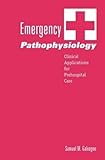Emergency Pathophysiology [electronic resource] : Clinical Applications for Prehospital Care.
Material type: TextPublication details: Hoboken : Teton NewMedia, Inc, 2014.Description: 1 online resource (429 pages)Content type:
TextPublication details: Hoboken : Teton NewMedia, Inc, 2014.Description: 1 online resource (429 pages)Content type: - text
- computer
- online resource
- 9781482234626 (electronic bk.)
- 1482234629 (electronic bk.)
- 616.02/5 21
- RB113
| Item type | Current library | Shelving location | Call number | Status | Date due | Barcode | Item holds | |
|---|---|---|---|---|---|---|---|---|
 Electronic Book
Electronic Book
|
Kuakarun Nursing Library | Processing unit | Online Access | Eb34948 |
Front Cover; Dedication; About the Author; Acknowledgements; Preface; References; Contents; Section I: General Principles; 1. Cell Physiology; 2. Body Fluids and Fluid Therapy; 3. Oxygen Transport; 4. The Autonomic Nervous System; 5. Pharmacokinetics; Section II: Respiratory Pathophysiology; 6. Pulmonary Physiology and Pharmacology; 7. Asthma; 8. Chronic Obstructive Pulmonary Disease; 9. Pulmonary Embolism; Section III: Cardiovascular Pathophysiology; 10. Basic Cardiac Physiology; 11. Cardiac Dysrhythmias; 12. Acute Coronary Syndromes I: Pathophysiology of Coronary Artery Disease.
13. Acute Coronary Syndromes II: Angina14. Acute Coronary Syndromes III: Acute Myocardial Infarction; 15. Heart Failure; 16. Hypertensive Emergencies and Urgencies; Section IV: Shock; 17. Hypovolemic Shock; 18. Anaphylactic Shock; 19. Septic Shock; Section V: Endocrine Disorders; 20. Diabetic Emergencies; 21. Adrenal and Thyroid Emergencies; Section VI: Gastrointestinal Emergencies; 22. The Acute Abdomen; 23. Gastrointestinal Bleeding; Section VII: Infectious Diseases; 24. Pneumonia; 25. Infectious Disease Emergencies; Section VIII: Neurological Disorders; 26. Acute Cerebral Infarction.
27. Status Epilepticus28. Neurological Trauma; Section IX: Environmental Emergencies; 29. Hypothermia; 30. Heat Stroke and Heat Exhaustion; Appendices; I: Pharmacology of Rapid Sequence Intubation; II: Essentials of 12-Lead Electrocardiograph Interpretation; III: Essentials of Acid-Base Interpretation.
This core textbook defines the pathophysiologic mechanisms underlying the disease states commonly encountered by pre-hospital care providers. The chapters are short, clinically focused and specific to the diseases, disorders, and traumatic conditions of critical interest to the EMT and pre-hospital environment. Each chapter identifies the appropriate drugs and management guidelines to be used. Designed to bridge the gap between EMT and the Physician in all emergent or acute conditions, the book includes management cautions and tips are highlighted throughout the presentation. The book is ta.
Description based on print version record.
There are no comments on this title.

